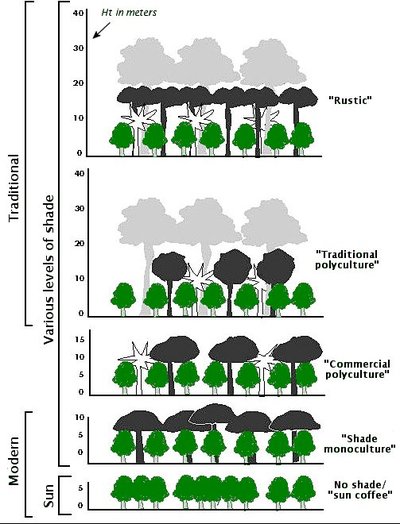Photo via prince_tigereye
♪ The best part of waking up, is Folgers in your cup ♪ Many of us grew up hearing this little jingle on the TV, but few (if any) of us considered the extent of the impacts that a cup of Joe has on the environment and people. Coffee is an interesting case study of a plantation crop that has wreaked havoc on ecosystems and local human communities in the tropics for decades, but actually has the potential to be an integral part of diverse and vibrant agro-ecosystems.
Now you've heard me go on about chocolate and how the ethics of consumption depend largely on how your cacao is grown and processed. Coffee presents many of the same challenges and benefits. Acting as the foundation for the livelihoods of 25 million people's, coffee production now covers an area larger than the size of Portugal.
Modern coffee plantations capitalize on the rapid growth and high yields resulting from direct sunlight afforded crops in monocultures, with no canopy of trees. Besides the obvious downsides of habitat loss, these systems also quickly degrade as soil erodes and loses nutrients rapidly. However, traditional production methods capitalize on the nature of this understory shrub or small tree by leaving the forest intact.
A month back, NPR host Guy Raz interviewed UC Berkeley (beat Cal) researcher Shalene Jha about how coffee cultivation can actually promote biological diversity. By maintaining a forest canopy, habitat for migratory birds, protection for essential pollinators, deterrents for pests, and water/soil filtration process are preserved. This in turn, fostering high biodiversity, also supports healthy crops and increases the resilience of such food systems! So scour the shelves of your grocery store for shade-grown coffee or google it and proceed to be overwhelmed. More and more manufacturers are jumping on board...well, maybe not Folger's.
Food for thought: Caffeine is actually the toxic substance meant to ward off seed predators in the wild...similar to nicotine in tobacco plants.
Learn More:
Maps: Coffee-Producing Regions via National Geographic or Conservation International


3 comments:
Really interesting! Thanks for enlightening us :)
for most, the sun is money. You need a plan that includes canopy trees that are smaller and spaced correctly so that they don't "over-shade" the coffee trees within a few years.
to me its not what is done for the birds, eventually a coffee orchard will become a coffee forest, probably with wild trees on the neighbor's property too.
as long as there are trees and that the coffee farmer is actively conserving water and soil than i find that more important being shaded.
I imagine a synthesis of a 100% off grid, all on-farm inputs, permacultural conservation, and biodynamics. we shouldn't neglect the ether which is affected and surrounds all.
if the soil is not being taking care of; washing away, pummeled with fertilizers and pesticides, left bare and compacted. That to me is a crime on any farm and should not be tolerated.
So next time you take a sip of your coffee think about whether your action is causing that precious layer of organic matter in the tropics to degrade and flow to sea. Without soil we cannot have civilization. Without forests we cannot maintain life.
Excellent post!I hope you could add this Coffee widget at the end of this post so we could add links to your blog.Thanks!
Post a Comment